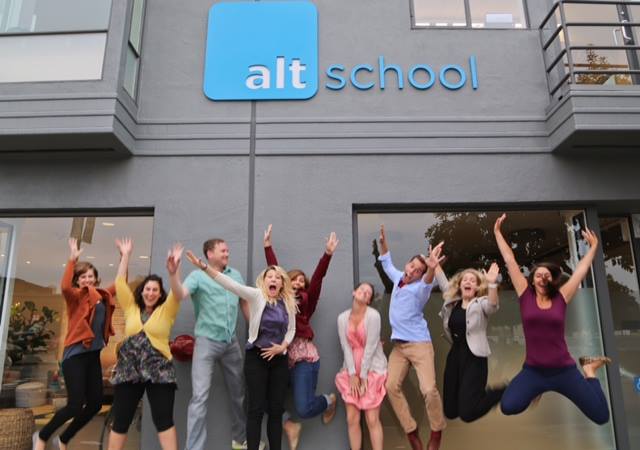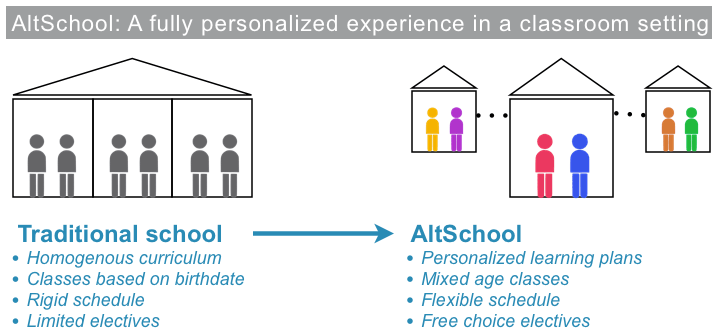An alternative to outdated schools

As our educational system struggles to adapt to the rapidly changing world, Altschool is bringing classrooms into the twenty-first century by using technology to offer students a personalized education.
No one needs convincing about the value of an education. That said, one can argue that our educational system, as well intentioned as it might be, is outdated and falling behind the rapidly changing times. The twenty-first century demands a different type of student – one that can think critically, solve multi-disciplinary problems, effectively communicate, operate both independently and in a team, and learn and employ new technological tools. Likewise, with our current one size fits all schooling, some students are being left behind while others are being held back by an inability to move faster than their class.
Here is where Altschool comes in. Founded in 2014 by a former Google executive, Max Ventilla, the startup attempts to leverage technology to provide a personalized education aimed at cultivating twenty-first century skills while encouraging students to pursue their passion. Altschool currently has 9 micro-schools spread throughout the San Fransciso Bay Area and New York City that cover pre-kindergarten to grade eight [1]. These schools differ from traditional schools in many ways including having a 1 to 7 teacher-to-student ratio, mixed age and grade level classrooms, and a much greater usage of technology [2].
Altschool is a private company with a two-fold business model. Through its micro-schools, it strives to provide students a superior personalized education, while building out its technology, and captures some value for itself by charging approximately $30,000 a year in tuition[4]. However, its long-term intention is to build out a complete suite of software for educators, and sell its technology and related services (e.g., teacher training) in a subscription model to schools[5].
Unlike traditional schools, Altschool employs technology throughout much of its operations. Students are given tablets in pre-kindergarten and laptops in later years [6]. Teachers assign each student different modules to work through the Altschool Playlist software – these modules “include individualized, small group, and whole class learning experiences” and are decided based on the curriculum, and the student’s progress and interests [7]. Student progress is captured in detail and available to teachers. Teachers can also choose to send updates to parents through Altschool Stream [8]. Perhaps most unique, classrooms feature AltVideo, a full audio and video surveillance system that records classes and allows for analysis of lessons and interactions [9]. Altschool’s platform also includes iterative student report cards and classroom management tools (e.g., attendance tracking) [10].
 [11]
[11]
These technology-enabled operations create an ever-growing amount of data, and Altschool leverages this to track and make available each student’s learning journey, help teachers improve their own effectiveness, and better personalize student content (for instance by recommending relevant modules for teachers to assign students) [12]. Additionally, teachers share best practices and policies through an internal wiki-like product, and regularly work with the product team on product improvement and new product development [13]. In a nutshell, Altschool’s use of technology is allowing for the creation of much tighter feedback loops for improving student learning and teacher effectiveness.
Looking towards the future, Altschool is starting to partner with external schools to grow faster by having them adopt its software. While the schools run by Altschool are idealized environments to build and test their technology, there will be bumps along the road in having external schools adopt their technology. There is still a large digital divide and technology is not easy for all schools, educators, students, or parents to adopt. For instance, students may be loaned a laptop to take home but fail to have internet access. For more schools to adopt their software, and move towards a personalized learning model, I think Altschool should invest in:
- Robust teacher training and professional development as well as capacity building measures for schools and districts
- Thinking end-to-end about the experience for different students and teachers and addressing common barriers to adoption
- Specifically addressing how technology can create a divide between social-economic classes. For instance, testing low-cost ways for students to continue learning despite technological barriers (e.g., making content available offline)
- Thinking how their software will need to be adopted for students with special needs (e.g., learning disabilities, physical disabilities, etc.)
I would also be extremely cognizant of student data security and privacy. Data breaches are becoming commonplace, and an occurrence of one would create significant negative PR and risk schools backing out of adopting the software. Lastly, Altschool should consider expanding its partnerships with third-party educational technology and content providers to expand its content base and tools for learning as opposed to having to create everything from scratch.
William Butler Yeats suggested that “education is not the filling of a pail, but the lighting of a fire,” let’s hope that Altschool can succeed in its efforts to stoke this fire and make personalized education available for all! (Word count: 796)
 [14]
[14]
Sources:
1. The New Yorker, “Silicon Valley disrupts education,” http://www.newyorker.com/magazine/2016/03/07/altschools-disrupted-education, accessed November 2016.
2. Techcrunch, “Altschool Raises $100M,” https://techcrunch.com/2015/05/04/altschool-raises-100m-from-founders-fund-zuckerberg-to-scale-a-massive-network-of-schools-around-personalized-learning/, accessed November 2016.
3. Altschool Blog, “Altschool model,” http://blog.altschool.com/hs-fs/hub/302069/file-626487806-png/unbundlingfinal2.png?t=1478736266321, accessed November 2016.
4. The New Yorker, “Silicon Valley disrupts education,” http://www.newyorker.com/magazine/2016/03/07/altschools-disrupted-education, accessed November 2016.
5. Techcrunch, “For the ambitious ed tech company AltSchool, it’s time for phase two,” https://techcrunch.com/2016/08/09/for-the-ambitious-ed-tech-company-altschool-its-time-for-phase-two, accessed November 2016.
6. The New Yorker, “Silicon Valley disrupts education,” http://www.newyorker.com/magazine/2016/03/07/altschools-disrupted-education, accessed November 2016.
7. Altschool Blog, “Bespoke Education,” http://blog.altschool.com/bespoke-education, accessed November 2016.
8. The New Yorker, “Silicon Valley disrupts education,” http://www.newyorker.com/magazine/2016/03/07/altschools-disrupted-education, accessed November 2016.
9. The New Yorker, “Silicon Valley disrupts education,” http://www.newyorker.com/magazine/2016/03/07/altschools-disrupted-education, accessed November 2016.
10. Techcrunch, “Altschool Raises $100M,” https://techcrunch.com/2015/05/04/altschool-raises-100m-from-founders-fund-zuckerberg-to-scale-a-massive-network-of-schools-around-personalized-learning/, accessed November 2016.
11. Techcrunch, “Altschool student,” https://tctechcrunch2011.files.wordpress.com/2015/05/altschool-student.jpg?w=828&h=552, accessed November 2016.
12. Wired, “Inside the School Silicon Valley Thinks Will Save Education,” https://www.wired.com/2015/05/altschool/, accessed November 2016.
13. Techcrunch, “Altschool Raises $100M,” https://techcrunch.com/2015/05/04/altschool-raises-100m-from-founders-fund-zuckerberg-to-scale-a-massive-network-of-schools-around-personalized-learning/, accessed November 2016.
14. Blog, “Altschool image,” http://bobbymarhamat.com/wp-content/uploads/sites/4/2015/03/altschool1.jpg, accessed November 2016.




This business model is fascinating to me. EdTech has typically been heralded as the end of Baumol’s Cost Disease vis a vis education, enabling you to effectively drive *up* the student:teacher ratio without sacrificing learning outcomes.
These guys appear to have taken the opposite approach, which is to double down on both human and technological inputs, ostensibly raising educational outcomes beyond anything that would be available in any other model today. It also has meant raising the price, so at $30k this model definitely isn’t going to be school for the masses. Interested to see, though, if this somehow serves as a vanguard to see which particular applications of technology and hybrid models of teacher-guided tech based learning will be applicable to more economical educational models.
This was an incredibly interesting read on how technology, particularly data-based personalisation is revolutionising the outdated education model. Having said that, I do share most of your concerns as well, AltVideo especially seems to be an extreme and intrusive foray into the integrity of the learning experience and I would definitely caution on finding the right balance on leveraging digital to improve the classroom experience without transgressing on students’ privacy, psychological safety and security.
To scale their business model sustainability, I do think packaging and white-labelling their software as an enterprise product offering for other schools and institutions is key.
Moreover, remote technology enabled education is an area that a lot of emerging markets are investing in in order to bridge the wide infrastructure, resource and skills gap prevalent in the region and offer students in unprivileged areas an equal opportunity in attaining a good education. If packaged appropriately, the software and the model will have a keen audience in markets like India, Vietnam and Indonesia who are trying to transform their education sectors through greater adoption of technology.
Super interesting read. It’s a bit mind blowing to realize that our current education model (teacher up front lecturing students) has been the dominant form of teaching for hundreds of years with minimal change. There’s no doubt that our education system overlooks a ton of brilliant students because it’s unable to see beyond the lecture system. Altschool has the incredible opportunity to help open the public’s eyes to multiple forms of learning.
Along the same lines as Parvathy, it’ll be interesting to see how Altschool and it’s customers (schools, teachers, parents, students) are able to digest and utilize the data gathered through recorded classes. There’s bound to be a steep learning curve for Altschool to be able to translate data into results, especially when there are so many factors of academic success that fall outside of the classroom. Getting teachers to accept Altschool findings will also be a huge challenge. Teachers invest so much time and energy, it’s not difficult to imagine significant pushback if the data points to something counter to teachers’ intuition. It’s essential that Altschool and the teachers are on the same page.
All this said, Altschool is doing some really amazing things and I hope that they can succeed in pushing our education system in the right direction.
I’m pretty fascinated by Altschool and I think what they’re trying to do is admirable. I do agree with your analysis that what they’re doing right now is very small scale, limited to their environment and exclusively available for the wealthier segments of population. I think the massive challenge for them would be in scaling. I personally think traditional schools aren’t going to be ‘disrupted’ for a long time. Since they’re building products for an extremely different environment than what is actually in regular schools, I think it will be challenging for them to adapt their products to the regular school environment. Very interested to see how this plays out in the future!